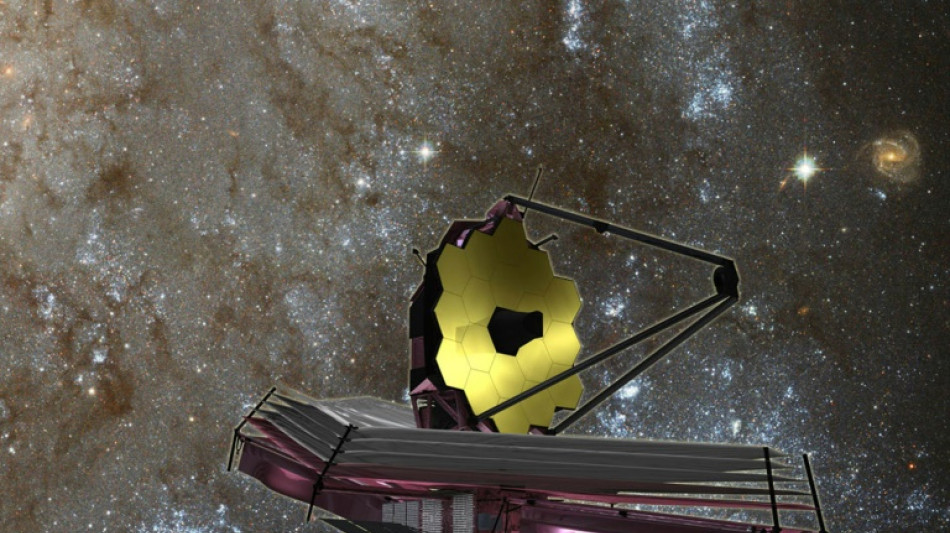
-
 UN chief slams landmine threat days after US decision to supply Ukraine
UN chief slams landmine threat days after US decision to supply Ukraine
-
Sporting hope for life after Amorim in Arsenal Champions League clash

-
 Head defiant as India sense victory in first Australia Test
Head defiant as India sense victory in first Australia Test
-
Scholz's party to name him as top candidate for snap polls

-
 Donkeys offer Gazans lifeline amid war shortages
Donkeys offer Gazans lifeline amid war shortages
-
Court moves to sentencing in French mass rape trial

-
 'Existential challenge': plastic pollution treaty talks begin
'Existential challenge': plastic pollution treaty talks begin
-
Cavs get 17th win as Celtics edge T-Wolves and Heat burn in OT

-
 Asian markets begin week on front foot, bitcoin rally stutters
Asian markets begin week on front foot, bitcoin rally stutters
-
IOC chief hopeful Sebastian Coe: 'We run risk of losing women's sport'

-
 K-pop fans take aim at CD, merchandise waste
K-pop fans take aim at CD, merchandise waste
-
Notre Dame inspired Americans' love and help after fire

-
 Court hearing as parent-killing Menendez brothers bid for freedom
Court hearing as parent-killing Menendez brothers bid for freedom
-
Closing arguments coming in US-Google antitrust trial on ad tech

-
 Galaxy hit Minnesota for six, Orlando end Atlanta run
Galaxy hit Minnesota for six, Orlando end Atlanta run
-
Left-wing candidate Orsi wins Uruguay presidential election

-
 High stakes as Bayern host PSG amid European wobbles
High stakes as Bayern host PSG amid European wobbles
-
Australia's most decorated Olympian McKeon retires from swimming

-
 Far-right candidate surprises in Romania elections, setting up run-off with PM
Far-right candidate surprises in Romania elections, setting up run-off with PM
-
Left-wing candidate Orsi projected to win Uruguay election

-
 UAE arrests three after Israeli rabbi killed
UAE arrests three after Israeli rabbi killed
-
Five days after Bruins firing, Montgomery named NHL Blues coach

-
 Orlando beat Atlanta in MLS playoffs to set up Red Bulls clash
Orlando beat Atlanta in MLS playoffs to set up Red Bulls clash
-
American McNealy takes first PGA title with closing birdie

-
 Sampaoli beaten on Rennes debut as angry fans disrupt Nantes loss
Sampaoli beaten on Rennes debut as angry fans disrupt Nantes loss
-
Chiefs edge Panthers, Lions rip Colts as Dallas stuns Washington

-
 Uruguayans vote in tight race for president
Uruguayans vote in tight race for president
-
Thailand's Jeeno wins LPGA Tour Championship

-
 'Crucial week': make-or-break plastic pollution treaty talks begin
'Crucial week': make-or-break plastic pollution treaty talks begin
-
Israel, Hezbollah in heavy exchanges of fire despite EU ceasefire call

-
 Amorim predicts Man Utd pain as he faces up to huge task
Amorim predicts Man Utd pain as he faces up to huge task
-
Basel backs splashing the cash to host Eurovision

-
 Petrol industry embraces plastics while navigating energy shift
Petrol industry embraces plastics while navigating energy shift
-
Italy Davis Cup winner Sinner 'heartbroken' over doping accusations

-
 Romania PM fends off far-right challenge in presidential first round
Romania PM fends off far-right challenge in presidential first round
-
Japan coach Jones abused by 'some clown' on Twickenham return

-
 Springbok Du Toit named World Player of the Year for second time
Springbok Du Toit named World Player of the Year for second time
-
Iran says will hold nuclear talks with France, Germany, UK on Friday

-
 Mbappe on target as Real Madrid cruise to Leganes win
Mbappe on target as Real Madrid cruise to Leganes win
-
Sampaoli beaten on Rennes debut as fans disrupt Nantes loss

-
 Israel records 250 launches from Lebanon as Hezbollah targets Tel Aviv, south
Israel records 250 launches from Lebanon as Hezbollah targets Tel Aviv, south
-
Australia coach Schmidt still positive about Lions after Scotland loss

-
 Man Utd 'confused' and 'afraid' as Ipswich hold Amorim to debut draw
Man Utd 'confused' and 'afraid' as Ipswich hold Amorim to debut draw
-
Sinner completes year to remember as Italy retain Davis Cup

-
 Climate finance's 'new era' shows new political realities
Climate finance's 'new era' shows new political realities
-
Lukaku keeps Napoli top of Serie A with Roma winner

-
 Man Utd held by Ipswich in Amorim's first match in charge
Man Utd held by Ipswich in Amorim's first match in charge
-
'Gladiator II', 'Wicked' battle for N. American box office honors

-
 England thrash Japan 59-14 to snap five-match losing streak
England thrash Japan 59-14 to snap five-match losing streak
-
S.Africa's Breyten Breytenbach, writer and anti-apartheid activist


Webb telescope finds CO2 for first time in exoplanet atmosphere
The months-old James Webb Space Telescope has added another major scientific discovery to its growing list: detecting for the first time signs of carbon dioxide in the atmosphere of a planet outside our solar system.
Although the exoplanet would never be able to support life as we know it, the successful discovery of CO2 gives researchers hope that similar observations could be carried out on rocky objects more hospitable to life.
"My first thought: wow, we really do have a chance to detect the atmospheres of terrestrial-size planets," tweeted Natalie Batalha, a professor at the University of California at Santa Cruz and one of hundreds who worked on the Webb project.
Their study of exoplanet WASP-39, a hot gas giant closely orbiting a star 700 light years away, will soon be published in the journal Nature.
"For me, it opens a door for future research on super-Earths (planets larger than Earth but smaller than Neptune), or even Earth-sized planets," Pierre-Olivier Lagage, an astrophysicist with France's Atomic Energy Commission (CEA), told AFP.
The detection of CO2 will also help scientists learn more about how WASP-39 formed, NASA said in a press release. The exoplanet, which orbits its star once every four Earth days, has a mass one-quarter that of Jupiter but a diameter 1.3 times bigger.
The frequency of its orbit and large atmosphere made WASP-39 an ideal candidate for an early test of Webb's state-of-the-art infrared sensor, known as NIRSpec.
Each time the exoplanet crosses in front of its star, it blocks out an almost imperceptible amount of light.
But around the edges of the planet, a tiny amount of light passes through the atmosphere.
Webb's highly sensitive NIRSpec can detect the small changes that the atmosphere has on the light, allowing scientists to determine its gas composition.
The Hubble and Spitzer telescopes had already detected water vapor, sodium and potassium in WASP-39's atmosphere, but carbon dioxide can now be added to that list thanks to Webb and its NIRSpec instrument.
"It was a special moment, crossing an important threshold in exoplanet sciences," said Zafar Rustamkulov, a Johns Hopkins University researcher, in the NASA press release.
B.Shevchenko--BTB




